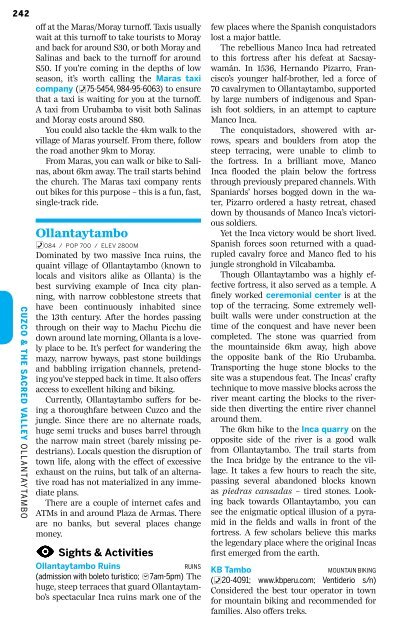peru-8-cuzco-sacred-valley
Create successful ePaper yourself
Turn your PDF publications into a flip-book with our unique Google optimized e-Paper software.
242<br />
Cuzco & the Sacred Valley T S O H I L G L E H A S T N AC S TAY & R E AC TA D T M VA I B V L O I T L I E Y S<br />
off at the Maras/Moray turnoff. Taxis usually<br />
wait at this turnoff to take tourists to Moray<br />
and back for around S30, or both Moray and<br />
Salinas and back to the turnoff for around<br />
S50. If you’re coming in the depths of low<br />
season, it’s worth calling the Maras taxi<br />
company (%75-5454, 984-95-6063) to ensure<br />
that a taxi is waiting for you at the turnoff.<br />
A taxi from Urubamba to visit both Salinas<br />
and Moray costs around S80.<br />
You could also tackle the 4km walk to the<br />
village of Maras yourself. From there, follow<br />
the road another 9km to Moray.<br />
From Maras, you can walk or bike to Salinas,<br />
about 6km away. The trail starts behind<br />
the church. The Maras taxi company rents<br />
out bikes for this purpose – this is a fun, fast,<br />
single-track ride.<br />
Ollantaytambo<br />
%084 / POP 700 / ELEV 2800M<br />
Dominated by two massive Inca ruins, the<br />
quaint village of Ollantaytambo (known to<br />
locals and visitors alike as Ollanta) is the<br />
best surviving example of Inca city planning,<br />
with narrow cobblestone streets that<br />
have been continuously inhabited since<br />
the 13th century. After the hordes passing<br />
through on their way to Machu Picchu die<br />
down around late morning, Ollanta is a lovely<br />
place to be. It’s perfect for wandering the<br />
mazy, narrow byways, past stone buildings<br />
and babbling irrigation channels, pretending<br />
you’ve stepped back in time. It also offers<br />
access to excellent hiking and biking.<br />
Currently, Ollantaytambo suffers for being<br />
a thoroughfare between Cuzco and the<br />
jungle. Since there are no alternate roads,<br />
huge semi trucks and buses barrel through<br />
the narrow main street (barely missing pedestrians).<br />
Locals question the disruption of<br />
town life, along with the effect of excessive<br />
exhaust on the ruins, but talk of an alternative<br />
road has not materialized in any immediate<br />
plans.<br />
There are a couple of internet cafes and<br />
ATMs in and around Plaza de Armas. There<br />
are no banks, but several places change<br />
money.<br />
1 Sights & Activities<br />
Ollantaytambo Ruins<br />
RUINS<br />
(admission with boleto turístico; h7am-5pm) The<br />
huge, steep terraces that guard Ollantaytambo’s<br />
spectacular Inca ruins mark one of the<br />
few places where the Spanish conquistadors<br />
lost a major battle.<br />
The rebellious Manco Inca had retreated<br />
to this fortress after his defeat at Sacsaywamán.<br />
In 1536, Hernando Pizarro, Francisco’s<br />
younger half-brother, led a force of<br />
70 cavalrymen to Ollantaytambo, supported<br />
by large numbers of indigenous and Spanish<br />
foot soldiers, in an attempt to capture<br />
Manco Inca.<br />
The conquistadors, showered with arrows,<br />
spears and boulders from atop the<br />
steep terracing, were unable to climb to<br />
the fortress. In a brilliant move, Manco<br />
Inca flooded the plain below the fortress<br />
through previously prepared channels. With<br />
Spaniards’ horses bogged down in the water,<br />
Pizarro ordered a hasty retreat, chased<br />
down by thousands of Manco Inca’s victorious<br />
soldiers.<br />
Yet the Inca victory would be short lived.<br />
Spanish forces soon returned with a quadrupled<br />
cavalry force and Manco fled to his<br />
jungle stronghold in Vilcabamba.<br />
Though Ollantaytambo was a highly effective<br />
fortress, it also served as a temple. A<br />
finely worked ceremonial center is at the<br />
top of the terracing. Some extremely wellbuilt<br />
walls were under construction at the<br />
time of the conquest and have never been<br />
completed. The stone was quarried from<br />
the mountainside 6km away, high above<br />
the opposite bank of the Río Urubamba.<br />
Transporting the huge stone blocks to the<br />
site was a stupendous feat. The Incas’ crafty<br />
technique to move massive blocks across the<br />
river meant carting the blocks to the riverside<br />
then diverting the entire river channel<br />
around them.<br />
The 6km hike to the Inca quarry on the<br />
opposite side of the river is a good walk<br />
from Ollantaytambo. The trail starts from<br />
the Inca bridge by the entrance to the village.<br />
It takes a few hours to reach the site,<br />
passing several abandoned blocks known<br />
as piedras cansadas – tired stones. Looking<br />
back towards Ollantaytambo, you can<br />
see the enigmatic optical illusion of a pyramid<br />
in the fields and walls in front of the<br />
fortress. A few scholars believe this marks<br />
the legendary place where the original Incas<br />
first emerged from the earth.<br />
KB Tambo<br />
MOUNTAIN BIKING<br />
(%20-4091; www.kb<strong>peru</strong>.com; Ventiderio s/n)<br />
Considered the best tour operator in town<br />
for mountain biking and recommended for<br />
families. Also offers treks.


